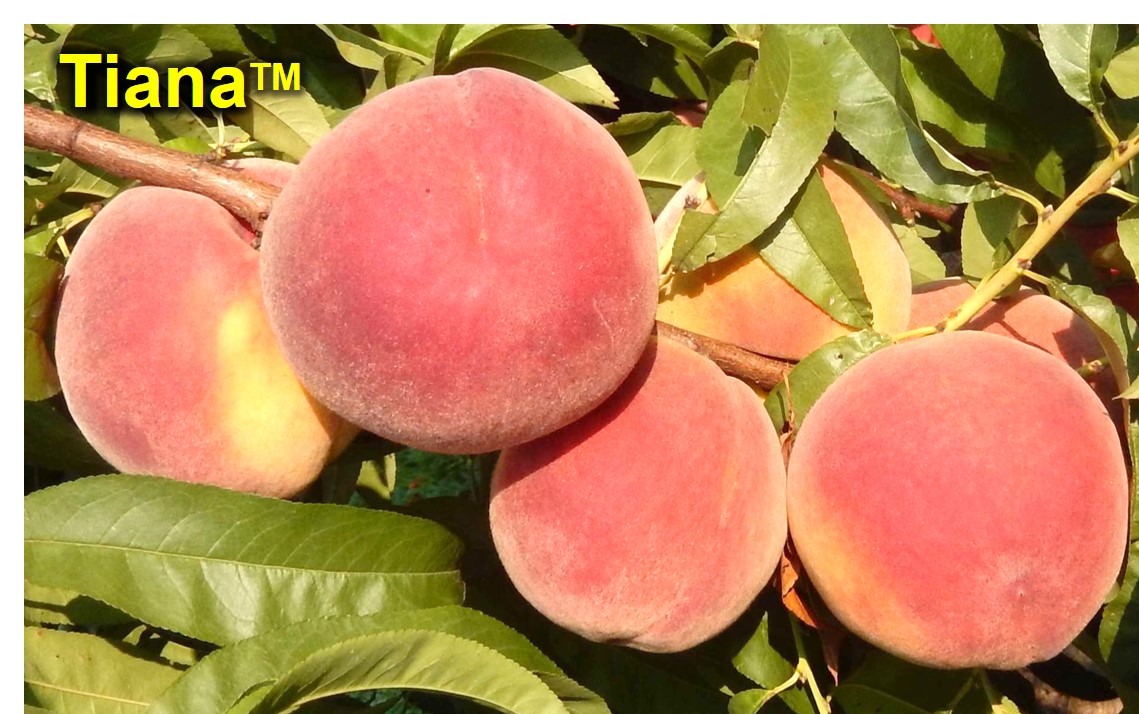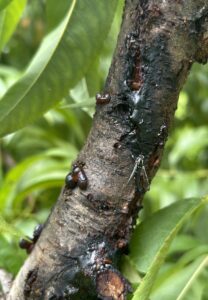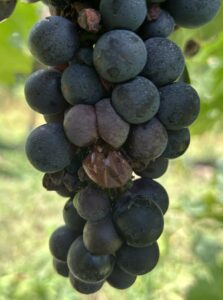Cooler temperatures and sunny days during the last 10 days have been ideal for full color and flavor development of late August and Early September peach varieties. Descriptions of fruit and tree characteristics, challenges, and laboratory evaluations of fruit physical and chemical properties (Table 1) of important varieties in this harvest window are described below. Understanding these characteristics is essential for selecting new varieties or replacing existing ones. Note that these varieties were evaluated in southern New Jersey; as a result, the harvest dates could be a few days later for the Central and Northern New Jersey orchards.
SelenaTM is a new yellow, melting flesh peach from the Rutgers Fruit Breeding program. It has an excellent firmness, slightly fibrous flesh around the pit, and ripens during and between ‘Jersey queen’ and ‘Encore’. Very large fruited with an attractive 50-80% mottled red and yellow background. The fruit hangs well on the tree and has an excellent balance of sweet and acidic flavor. This variety exhibits a low susceptibility to bacterial spot. Most importantly, like Gloria, the bloom is delayed and extended, resulting in trees always bearing a crop even during the hard frost years. Fruit maintains firmness after achieving commercial maturity and doesn’t drop fruit, like Encore and Jersey Queen.
 TianaTM is a new yellow freestone melting flesh peach, ripening between ‘Cresthaven’ and ‘Encore’, and overlaps with Encore and Selena. It has large fruit with an excellent balance of acidity and high sweetness. Skin is attractive, 50-75% mottled red-on-yellow background. This productive variety exhibits low susceptibility to bacterial spot. Like Gloria, the bloom is delayed and extended, resulting in trees always bearing a crop even during the hard frost years. Fruit maintains its firmness on the tree after achieving commercial maturity. It is a good candidate for replacing Encore.
TianaTM is a new yellow freestone melting flesh peach, ripening between ‘Cresthaven’ and ‘Encore’, and overlaps with Encore and Selena. It has large fruit with an excellent balance of acidity and high sweetness. Skin is attractive, 50-75% mottled red-on-yellow background. This productive variety exhibits low susceptibility to bacterial spot. Like Gloria, the bloom is delayed and extended, resulting in trees always bearing a crop even during the hard frost years. Fruit maintains its firmness on the tree after achieving commercial maturity. It is a good candidate for replacing Encore.
Jerseyqueen is a very large, oblong to ovate, 55-65% scarlet red over a yellow ground color; yellow-fleshed, freestone peach, ripening August 25-28, approximately 31 days after Redhaven. The flesh is firm with a sweet and mildly tangy flavor. The tree is very vigorous and moderately productive. Challenges: It has mild to medium susceptibility to bacterial spot. The variety is not fully productive on many peach sites and tends to produce doubles.
Flamin Fury® PF#27 is an attractive, large to very large, globose to ovate, 60-70% crimson red over a greenish yellow ground color, yellow-fleshed, freestone peach, ripening August 25-28, approximately 31 days after Redhaven. The flesh is firm with very good flavor. Challenges: It has a medium susceptibility to bacterial spot.
Flamin Fury® PF 28-007 is a large to very large, globose to ovate, 50-80% dark crimson red over greenish yellow ground color, yellow-fleshed, freestone ripening August 27-31, approximately 34 days after Redhaven. The flesh is firm to very firm with a sweet and tangy flavor, with some red around the pit. The tree is vigorous and productive with medium leaf susceptibility to bacterial spot. This is an attractive late-season variety with great size and color. Fruit hangs well and has more color than Cresthaven.
 Flameprince is a medium-large, firm, attractive 50-70% crimson red over a yellow ground color, yellow/white-fleshed, freestone peach ripening September 2-5, approximately 38 days after Redhaven. The flesh is firm to very firm, sweet, and mildly tangy. The tree is moderately vigorous and productive with medium susceptibility to bacterial spot. Challenge: Note: The fruit color develops early; hence, picking by size is recommended. Three to four pickings may be required to achieve a uniform crop.
Flameprince is a medium-large, firm, attractive 50-70% crimson red over a yellow ground color, yellow/white-fleshed, freestone peach ripening September 2-5, approximately 38 days after Redhaven. The flesh is firm to very firm, sweet, and mildly tangy. The tree is moderately vigorous and productive with medium susceptibility to bacterial spot. Challenge: Note: The fruit color develops early; hence, picking by size is recommended. Three to four pickings may be required to achieve a uniform crop.
AutumnstarTM is a large, globose to slightly ovate, 60-80% crimson red over a yellowish green ground color, yellow-fleshed, freestone peach ripening September 4-7, approximately 41 days after Redhaven. The fruit is attractive for a late-season variety. Fruit size is medium-large. The flesh is firm with a good balance of sweet and acidic flavor. The tree is vigorous and productive with low susceptibility to bacterial spot. Challenge: Some tree survival problems have been noted. The performance of this variety has varied from year to year. In some years, it’s hard to size to medium-large size.
Flamin Fury PF 36 is a globose, firm, yellow-fleshed free stone peach ripening during the first week of September—one of the best late-season peach varieties. Fruit is large to very large, sweet, mildly tangy, and mostly uniform in size. The tree is vigorous and highly productive with no bacterial spot.
Augustprince is a globose to slightly ovate, 60-90% crimson red over a yellowish red ground color, yellow-fleshed freestone peach ripening August 31 to September 3 or 37 days after Redhaven. The flesh is firm to very firm, melting, stringy, with a very good, slightly acidic flavor. The tree is vigorous, productive, and has low susceptibility to bacterial spot. This sister variety ripens close to Flame Prince but consistently has better size and firmness.
Some of the excellent, yellow-fleshed varieties with few serious challenges
Encore is a firm fleshed variety with decent tolerance to bacterial spot. The tree is productive and cold-hardy, and the fruit has decent eating quality. However, it has a drop tendency. Fruit blush development has been unsatisfactory in some years. Fayette: High susceptibility to bacterial spot. A popular variety. Laurol is firm-fleshed, peach with a very sweet and tangy flavor. It has a high susceptibility to bacterial spots. It can get tiny splits at the stem end, which don’t always open, but water can get in, resulting in black gum around the pit.
White-fleshed Peach
August Rose is an attractive late-season white-fleshed peach harvested 24 days after Redhaven and a few days after the Sugar Giant. It has a longer harvest window because commercially mature fruit retains firmness on the tree. The freestone fruit is very firm and has a delicious flavor and melting texture. 60-90% medium red on cream and sizes 2 ¾ – 3 inches in diameter, somewhat nonuniform in size. It is a very sweet, low-acid fruit that hangs well on the tree after commercial maturity. This tree is tolerant of bacterial leaf spot and constriction canker. It can fill the gap between Sugar Giant and Snow Giant.
Other white-fleshed peaches have serious challenges.
Snow King is challenging to grow in New Jersey due to its high susceptibility to bacterial spots and brown rot. Snowfire has a high susceptibility to bacterial spot. Snowfire has the same problems as Snow King – low productivity and high susceptibility to bacterial spot and brown rot. It ripens earlier than Snow King and has less red skin color. Opale. It is also very susceptible to brown rot. Benedict: The flavor is subacid and very good. The tree is upright, spreading, vigorous, moderately productive, and has medium to high susceptibility to bacterial spots. This peach ripens just after Sugar Giant but is not as attractive.
Articles on Previous Season Peach and Nectarine Varieties:
- Mid-August Peach and Nectarine Varieties for New Jersey – New and Standard. https://plant-pest-advisory.rutgers.edu/mid-august-peach-and-nectarine-varieties-for-new-jersey-new-and-standard/
- Early August Peach Varieties: https://plant-pest-advisory.rutgers.edu/early-august-peach-varieties-for-new-jersey-new-and-standard/
- Early August Nectarine Varieties: https://plant-pest-advisory.rutgers.edu/early-august-nectarine-varieties-for-new-jersey-summer-beaut-sunglo-and-flavortop/
- Late-July Peach Varieties: https://plant-pest-advisory.rutgers.edu/late-july-peach-varieties-for-new-jersey-new-and-standard/
- Late-July Nectarine Varieties: https://plant-pest-advisory.rutgers.edu/late-july-nectarine-varieties-for-new-jersey-new-and-standard/
- Mid-July Nectarine Varieties: https://plant-pest-advisory.rutgers.edu/mid-july-nectarine-varieties-for-nj-silvergem-silverglo-easternglo-and-avalon/
- Mid-July Peach varieties: https://plant-pest-advisory.rutgers.edu/mid-july-peach-varieties-gala-pf-8-ball-summer-serenade-july-rose-and-pf-lucky-13/
- Early July Peach Varieties: https://plant-pest-advisory.rutgers.edu/early-july-peach-varieties-sentry-glenglo-ruby-prince-garnet-beauty-and-sugar-may/
- Late June Peach Varieties: https://plant-pest-advisory.rutgers.edu/late-june-peach-varieties-for-new-jersey-new-and-standard/









 The Rutgers Office of Continuing Professional Education will host a course on ‘Spanish for Ag and Horticulture Workforce’ from January 16-March 6, 2026. This is an online, self-paced course with approximately 21 hours of course content designed to help participants study conversational Spanish and gain technical vocabulary specific to those in the agriculture and horticulture workforce.
The Rutgers Office of Continuing Professional Education will host a course on ‘Spanish for Ag and Horticulture Workforce’ from January 16-March 6, 2026. This is an online, self-paced course with approximately 21 hours of course content designed to help participants study conversational Spanish and gain technical vocabulary specific to those in the agriculture and horticulture workforce.


